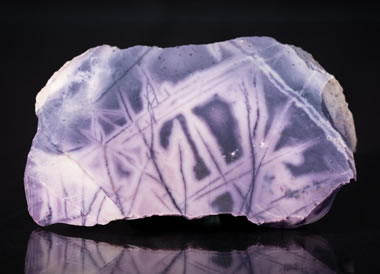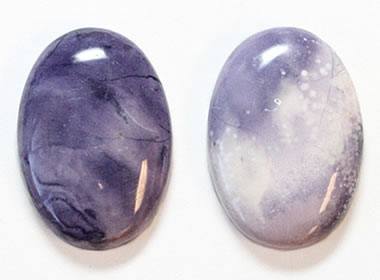 When I first heard of Tiffany Stone, I expected it to be a soft, cool aqua, like the Tiffany Jewelry boxes; Pantone 1837 for those of you who, like me, love side trips when you're doing research. The color number refers to the year that Tiffany & Co. was founded. That wasn't the color. It's purple!
When I first heard of Tiffany Stone, I expected it to be a soft, cool aqua, like the Tiffany Jewelry boxes; Pantone 1837 for those of you who, like me, love side trips when you're doing research. The color number refers to the year that Tiffany & Co. was founded. That wasn't the color. It's purple!
Tiffany Stone is also the name of an actress known for her work in A Very Harold & Kumar 3D Christmas.
Enough trivia. Back to the important stuff, rocks!
YUP, ROCKS
A lot of what I write about in my blog is committing lapidary on minerals, but Tiffany Stone is actually a rock. Here's the difference:
MINERAL: A mineral has a specific chemical composition and you will see the chemical formula for each mineral tells what the chemicals in the mineral are and their proportions. For example, the mineral Quartz is SiO2 which tells you it is made up of Si, or silicon, and oxygen. Some varieties, like Rose Quartz, have colors as a result of inclusions, but the inclusions don't change the formula. Usually, minerals each have a distinctive crystal formation that results from the atoms of their formula. For more details on how this works, Click Here
 ROCK: Unlike minerals that always have the same formula, rocks are formed as an aggregate that includes more than one mineral. Rocks are not identified by their chemical formula, but by the way they are formed; Igneous (formed by fire), Metamorphic (changes over time), and Sedimentary (mineral or organic bits that have settled and hardened). Tiffany Stone is a sedimentary rock that is primarily fluorite with additions including opal, calcite, quartz, and others.
ROCK: Unlike minerals that always have the same formula, rocks are formed as an aggregate that includes more than one mineral. Rocks are not identified by their chemical formula, but by the way they are formed; Igneous (formed by fire), Metamorphic (changes over time), and Sedimentary (mineral or organic bits that have settled and hardened). Tiffany Stone is a sedimentary rock that is primarily fluorite with additions including opal, calcite, quartz, and others.
BEWARE
When you see some at a show or online and it's expensive, don't be surprised. The only place it is mined in the world is at the Brush Wellman beryllium mine at Spor Mountain in western Utah. If a vendor tries to tell you it is so expensive because it is imported from China or Africa, walk away. It's expensive because it's rare.
TIFFANY STONE ON THE LAPIDARY BENCH
I purchased my specimens at the Arizona shows in the winter. I got two nice, but not remarkable, nodules.
When I sliced the first one, I noticed it was awfully soft. Depending on your source, it will run between 4-5.5 on the Mohs scale, and even at the top hardness it is a pretty soft stone. When you make cabochons with it, plan to mount them in protected settings (not rings) because it's very easy to scratch, ruining the surface finish.
One of the distinctive aspects of Tiffany Stone is the swirling pattern often found. It became a problem for me because my piece was so soft that a bit of it flaked off where the swirl met some different-colored material on my grinder wheel. I stopped right there and stabilized all my slabs before continuing any further.
I also realized that I could skip some of my wheels because of the softness. I have a 50,000 grit wheel which normally makes anything shine, but I found it took cerium oxide on leather to get the best possible finish which was a luster more than a shine.
WOULD I BUY IT AGAIN?
That's the question I ask myself when I'm working with a new material. I'm afraid my answer is that I probably won't.
On the plus side, it's easy to work on (after I stabilized it).
On the minus side, it's expensive and doesn't take a real shine. My pieces are roughly the same color as amethyst/purple sage agate which is much harder and reliably takes a high shine.
Have you worked with this material? If so, what was your impression?
I hope you enjoy my blog post. If you have any questions, let me know and I'll do my best to answer them. All the photos in this post were taken by me. They are available for a small fee. Please do not take and use them without permission--it's stealing. Thanks for supporting ethical behavior on the Web!
See you next time!
Your Lapidary Whisperer,
Donna
found in beryllium ore found in beryllium ore

A Tiffany Stone nodule, sliced in half and polished. Can you see why some people call it "ice cream stone"? Public domain image by Scott Horvath, USGS.
What Is Tiffany Stone?
"Tiffany stone" is a trade name used for a purple, blue and white gem material that can be cut and polished into beautiful beads, cabochons and tumbled stones. Geologically, Tiffany stone is a rock composed primarily of fluorite with smaller amounts of opal, calcite, dolomite, quartz, chalcedony, bertrandite and other materials. Other names used for Tiffany stone are "opalized fluorite," "ice cream stone," and "bertrandite."

Utah Tiffany Stone: "Tiffany Stone" is an unusual material found as mineralized nodules in a beryllium tuff at the site of the Brush-Wellman beryllium mine. It is thought to be an opalized fluorite. Tiffany Stone is also known as "bertrandite" and "ice cream opal." It is a rare material found only at the Brush-Wellman location.
Where Is Tiffany Stone Found?
Tiffany stone is a rare material. It is mined at one location worldwide - the Brush Wellman beryllium mine, at Spor Mountain, western Utah. It occurs there as nodules that are part of the ore produced at the mine. The nodules typically contain between one and two percent beryllium by weight.
The United States Geological Survey reports that the nodules are carbonate clasts that have been largely replaced by fluorite. Small amounts of bertrandite, a beryllium mineral with a chemical composition of Be4Si2O7(OH)2, occurs as submicroscopic grains within the fluorite.
Almost all of the Tiffany stone mined at Spor Mountain is crushed and used to produce beryllium. A small amount has been carried out of the mine by employees, and a small amount has been gathered by collectors who have rarely been allowed into the mine. These are the only sources of the gem material because Brush Wellman has always been interested in producing beryllium and has not been interested in Tiffany stone.
Other Names for Tiffany Stone
The most appropriate name for Tiffany stone is “opal fluorite” or “opalized fluorite.” These names reasonably represent the composition of most specimens. Another popular name is “bertrandite.” That name is incorrect because bertrandite is a mineral, which only comprises a few percent of the rock known as Tiffany stone. It is also called "ice cream stone" because of its delicious color.
There are numerous stories behind the name “Tiffany Stone.” Some people attribute the name to Tiffany and Company, the famous luxury goods retailer. The company has never been associated with the mine or with Tiffany stone. Others attribute the name to the daughter of a Brush Wellman employee who collected the colorful nodules brought home by her father. This story is possible, but the names of the miner or his daughter are not found in any written record.
Where Can You Buy Tiffany Stone?
Jewelry made with Tiffany stone is unlikely to be found in a mall jewelry store. Instead, it is most likely to be sold at a gem and mineral show, at a rock shop, or by a lapidarist at a craft show. You might also find it at an online craft marketplace such as Etsy. Some of these sellers are likely to be the same person who cut the stone and made the setting. You will rarely find that when buying diamonds, emeralds, rubies or sapphires!
About Using Tiffany Stone in Jewelry
Although Tiffany Stone can be very attractive, there is an important thing to consider when using in jewelry - it has a Mohs hardness of only 5 to 5 1/2. That makes it very easy to scratch. If Tiffany Stone is used in a ring, it will quickly show signs of wear and lose its nice polish and luster. For that reason, Tiffany Stone is best used in pendants, beads, earrings and other types of jewelry that will not be subjected to abrasion.
One thing about Tiffany Stone that will probably make you happy is its price. Even though it is very rare and quite beautiful, cabochons with beautiful color, pattern and size can usually be purchased for $75 or less. It also looks great in white metal. That allows it to be placed in a sterling silver setting, getting you the whole piece for a price of $150 or less.
A


